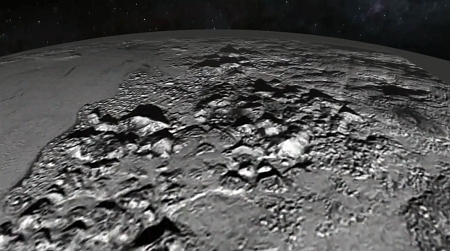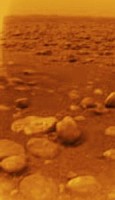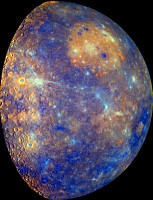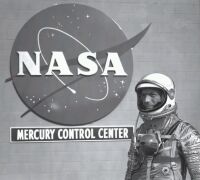|
|
| ||||||||||||||||||||||||||
Mars has its own page: Mars News & Linksoperational: New Horizons Pluto Flyby & Kuiper Belt Flyby11,000 foot high mountains on Pluto, photo by New Horizons on 2015-07-14
The JHU/APL New Horizons spacecraft is the first mission to probe the dwarf planet Pluto, its companion Charon, its four smaller moons, and the Kuiper Belt at the edge of our solar system. The 1,000-pound (453-kg) spacecraft was launched by a Lockheed Martin Atlas 5 vehicle from Launch Complex 41 at the Kennedy Space Center on January 19, 2006. On February 28, 2007, New Horizons took pictures as it flew past Jupiter on its way to Pluto. It took New Horizons 9½ years to travel all the way to Pluto, with which it reached closest approach on July 14, 2015. After the Pluto flyby, New Horizons will spend about 16 months transmitting back to Earth all the photos and other data gathered at Pluto. Then New Horizons, if funded, will encounter other objects in the Kuiper Belt from 2016 to 2020. enroute: Juno Jupiter OrbiterJuno, NASA & JPL's next Jupiter orbiter, was launched from Cape Canaveral on August 5, 2011, and is expected to enter a polar orbit around Jupiter in August, 2016. Juno "will conduct an in-depth study of the giant gas planet Jupiter. [The] spacecraft will enter polar orbit around the planet to investigate the existence of an ice-rock core; determine the amount of global water and ammonia present in the atmosphere; study convection and deep wind profiles in the atmosphere; investigate the origin of the jovian magnetic field; and explore the polar magnetosphere." Juno spacecraft & instruments graphic - SWRI Juno siteoperational: Cassini-Huygens Saturn OrbiterThe JPL Cassini-Huygens Saturn Orbiter entered Saturn's orbit on July 1, 2004, decelerated by the spacecraft's engine burning for 96 minutes, and began sending back high-quality photos of Saturn's rings, moons, and atmosphere. The six-ton spacecraft was launched on October 15, 1997 from the Kennedy Space Center on a Titan IVB/Centaur launch vehicle, swinging past Venus twice and Earth again once to pick up speed from a gravity-assist trajectory on its way to Saturn.At the JPL site you can learn about the spacecraft and its science objectives, check the probe's current position, and look at the latest images of Saturn and its moons. The US-built Cassini orbiter carried with it the Huygens Titan lander, built by the European Space Agency, which separated from the larger craft on December 25th, 2004 and landed on Titan, Saturn's largest moon, on January 14, 2005. As it descended by parachute, Huygens explored the thick atmosphere of Titan, sending photos and data back to Earth relayed via the Cassini orbiter.
operational: Messenger Mercury OrbiterThe JHU/APL Messenger spacecraft is a Mercury orbiter that was launched on August 3, 2004. Operated by the Applied Physics Laboratory at Johns Hopkins University, Messenger is the first spacecraft to visit Mercury since Mariner 10 over 30 years ago.Messenger entered orbit around Mercury on March 18, 2011, after taking a circuitous "gravity assist" flight path to get there. Even during the flybys, Messenger began mapping most of the planet in color, including areas unseen by Mariner 10, and measuring the composition of the surface, atmosphere and magnetosphere. Messenger Mercury image gallery
operational: Venus ExpressThe European Space Agency's Venus Express spacecraft was launched atop a Starsem Soyuz/Fregat LV from Baikonur, Kazakhstan, on November 9, 2005, and entered Venus orbit in April, 2006. The 1270 kg spacecraft carries a camera, three spectrometers and a magnetometer to study the Venusian atmosphere and clouds. Venus Express image galleryPlanetary Probe Spacecraft No Longer OperatingThe JPL Galileo Jupiter Orbiter studied & photographed Jupiter & its moons for almost 8 years before being deorbited to burn up in Jupiter's atmosphere on Sept 21, 2003. Galileo photosPlanetary Missions & Planetary Probe SpacecraftThe Jet Propulsion Laboratory, JPL, is home of the project administration and mission control for most US planetary probes and other unmanned spacecraft.The Solar System Exploraton site, which includes overviews of most past, current, and planned planetary exploration missions, has news and information about planetary research and the technologies used in it. The JPL Planetary Data System (PDS) "archives and distributes scientific data from NASA planetary missions, astronomical observations, and laboratory measurements". NASA Missions links to NASA planetary projects. ESA Solar System links to European Space Agency planetary projects. The NASA History Office has countless pages of history information and images to view from past planetary missions such as Mariner, Pioneer, Voyager, Viking, Magellan, and others. Planetary Maps, Planet Photos, Solar System ImagesNASA-JPL Eyes on the Solar System "is a 3-D environment full of real NASA mission data... See the entire solar system moving in real time." Use NASA Eyes to see the current position of the planets and planetary probe spacecraft. Similar to Google Earth, NASA Eyes requires a one-time free software download and installation....Planetary Maps and Images continuedThe NASA-JPL Planetary Photojournal provides access to planet images from NASA spacecraft.Space Renderings by Björn Jónsson Planetary Image Maps by James Hastings-Trew The JPL Solar System Simulator allows you to view perspective still images to and from 32 planets and moons from any virtual point in the solar system. The US Geological Survey Astrogeology Research Program has free downloadable maps (and cut & paste globes) of several planets, some moons, and some asteroids, including Venus, Earth's moon, Mars, and Jupiter's four Galilean moons, Callisto, Europa, Ganymede, and Io. Some of the maps are unlabeled photomosaics, some are geologic maps, others are labeled image maps with named features, and some are in "Map-a-Planet" clickable online atlas versions. The NASA-GSFC Catalog of Spaceborne Imaging is a planetary image archive from NASA's Goddard Space Flight Center, with over 500 comet, asteroid, and planet photographs collected by a variety of NASA spacecraft. NASA GSFC SkyView is a virtual observatory that generates images of any part of the sky at wavelengths ranging from radio to gamma rays. Like TerraServer pointed up instead of down, only moreso. Pluto Demoted, Only 8 Planets: In September, 2005, the discovery was announced of an object called 2003 UB313, which is larger than Pluto, and orbits the Sun from a distance three times as far away as Pluto. In September, 2006, the name of this object was officially deemed "Eris," after the Greek goddess of warfare and strife. The discovery of Eris led the International Astronomical Union to change their official definition of a planet, and deem Eris and Pluto "dwarf planets," leaving the Solar System with 8 planets instead of 9. At the 26th IAU General Assembly in August, 2006, the IAU resolved:
Extrasolar PlanetsThe Extrasolar Planets Encyclopedia has statistics and links about extrasolar planets and brown dwarfs.Spectrashift provides information and links about amateur astronomers looking for extrasolar planets using redshift radial velocity measurements. |
|
NASA Books (NASA Special Publications) & Other Astronomy Books Online
|
Some of the books below are Adobe .pdf files, which are nice for reading materials offline. If you would like to read NASA's .html online books, like most of those below, when you are offline, you can "harvest" the pages and images for free using HTTrack, a very useful freeware website capture and offline browsing tool. HTTrack also works well with groups of .pdf files linked to from a page or directory. | ||
|
Evolution of the Solar System SP-345 (1976) Origin of the Moon conference papers (1984) LPI Ranger Photographs of the Moon text & images from SP-61, SP-62, SP-63, SP-111, & SP-112, (1964-66) two 4.6 MB .pdf files & many jpegs LPI Lunar Map Catalog LPI Consolidated Lunar Atlas LPI Lunar Orbiter Photographic Atlas of the Moon 675 photos + annotations LPI Apollo Image Atlas almost 25,000 lunar images, + earth, astronauts & hardware Basaltic Volcanism on the Terrestrial Planets (1981) Planetary Geology in the 1980s SP-467 (1985) |
The Voyage of Mariner 10: Mission to Venus and Mercury SP-424 (1978) Atlas of Mercury, SP-423 (1978), from Mariner 10 images Magellan: The Unveiling of Venus JPL 400-345 (1989) Far Travelers: The Exploring Machines SP-480 (1985) Pioneer Odyssey, SP-349/396 (1977), about the Pioneer 10 Jupiter flyby Voyager 1 and 2 Atlas of Six Saturnian Satellites SP-474 (1984) Uplink-Downlink: A History of the Deep Space Network, 1957-1997 SP-4227 (2001) To read Uplink-Downlink offline, go to the SP-4227 directory and use HTTrack to download. Deep Space Communications and Navigation Series page linking to 6 .pdf tech books over 100 NASA online books are listed on the NASA News page | |



